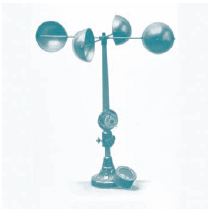Weather FundamentalsMeasurements |
How is wind speed measured |
Wind speed is measured with a device called an anemometer, which was an invention of English physicist Robert Hooke (1635-1703). The most commonly used type is the rotating cup anemometer, which uses three or four small cups that spin around a central pole. Modern anemometers of this sort work using electricity and magnets. As the cups spin, a reed switch within the central pole detects each time a magnet in a cup swings by. This sends out an electronic pulse that has been calibrated to calculate wind speed. The data is then transmitted to a weather station.

An early anemometer designed by John Thomas Romney Robinson in 1846. (photo by Sean Linehan, NOS, NGS, courtesy NOAA)
